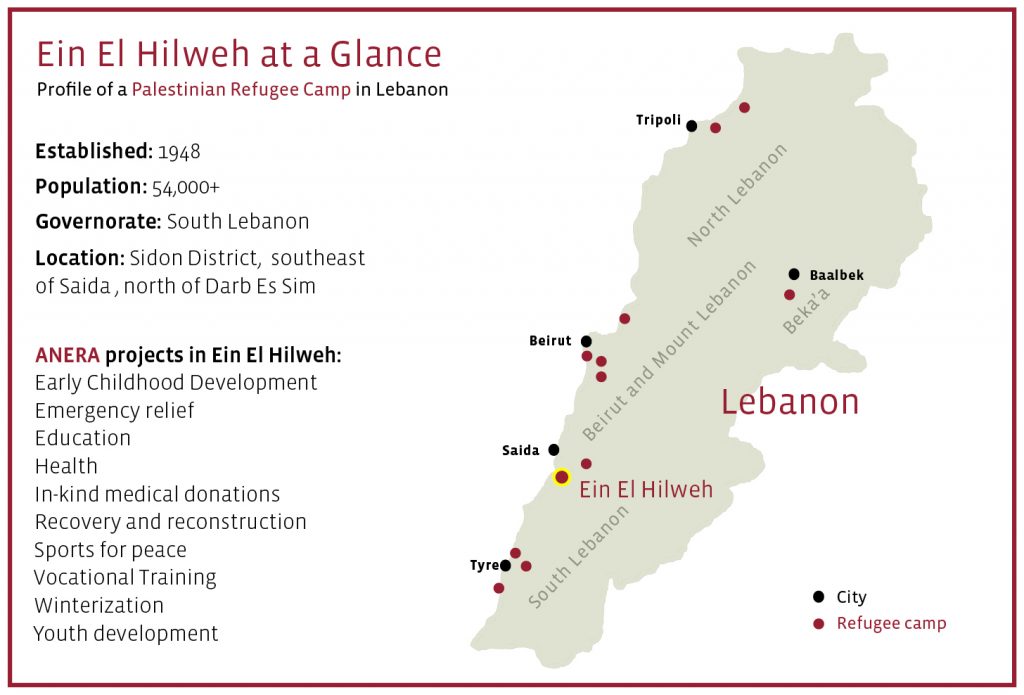Location of Ain el Hilwe south of Sidon (Saida) Source: American Near East Refugee Aid
6/9/17
By: Caleb Weiss
Lebanon’s Ain el Hilwe Palestinian refugee camp in the country’s south has long been a hotbed of extremist activity and general lawlessness. As per the 1969 Cairo agreement between Lebanon and Yassir Arafat, Lebanese security forces cannot enter Palestinian refugee camps. This means that Palestinian forces are responsible for their own security inside the camps.
However, due to rivalries between different factions for either political or religious reasons, this means that security has often been tenuous at best. This is doubly true for Ain el Hilwe, the largest Palestinian refugee camp in Lebanon. The camp sits close to the southern city of Sidon and hosts around 70,000 Palestinians and since 2011, thousands of Syrians. [1] This influx has led to numerous skirmishes, assassinations, and other acts of unrest as tensions between Palestinian authorities and more radical elements in the camp have boiled.
Prior to the outbreak of the Syrian Civil War, though, the camp was already host to several radical groups, including some linked to al Qaeda. This includes the Fatah al Islam (FaI) group, the group at the epicenter of the 2007 conflict in Lebanon. [2] FaI has also been linked to al Qaeda, as seen with several key leaders of the group and deployments of fighters to Iraq and Syria. [3] [4] [5]
Due to the 2007 conflict and the killing of several leaders, Fatah al Islam, and its ally Jund al Sham, have been severely degraded. In recent years, fighters from both groups (and some smaller units) have gravitated towards a figure named Bilal Badr according to David Daoud, a research analyst at the Foundation for Defense of Democracies. [6] Not much is known about Badr, however, it is thought he is around 33 years old. [7] Badr has also been described as a key leader of Fatah al Islam, thus making him an al Qaeda-linked figure. [8] His group, aptly named the Bilal Badr group, has been responsible for several skirmishes, assassinations, and increased tensions inside Ain el Hilwe for the past several years.
In 2015, after a series of assassinations and bombings linked to Bilal Badr group and others, the major factions inside Ain el Helwe formed a new joint security force. [9] These forces are comprised of members of 17 factions inside the camp and is led by Fatah. However, this alliance largely failed after political disagreements. Two years later, renewed efforts were able to establish a new joint security force for Ain el Helwe. [10] When these forces finally deployed in early April of this year, they were met with stiff resistance from the Bilal Badr group.
This resulted in five days of intense clashes inside the camp, leaving almost ten people killed and dozens wounded. [11] The new joint security forces were finally able to gain control over Badr’s Tiri neighborhood as Badr reportedly fled the camp. [12] Despite this, sporadic clashes and explosions have been reported since — all of which have been blamed on Bilal Badr group.
https://www.youtube.com/watch?v=3IDS3DjNYio
Video from the April 2017 clashes in Ain el Helwe.
These sporadic attacks are likely meant to provoke another large-scale clash akin to the one seen in April. It remains to be seen if these attacks will generate the intended result or if the joint security forces can keep the relative peace inside the camp. The joint security force recently announced the full deployment of its forces inside the camp; however, just last week, three people were injured by Bilal Badr’s fighters in new clashes in the Tiri neighborhood. [13]
As the joint security force struggles to bring relative peace and fight back against extremist activity in the camp, the Bilal Badr group continues to act as a spoiler. In addition, the influx of Syrians, and reported militants from Syria, to the camp also does not bode well. Of course, internal Palestinian politics can also jeopardize the future of the joint security force — and activities by extremists in the camp can also heighten these tensions. But until the joint security forces proves to be a capable policing unit inside the camp, Ain el Helwe will likely continue to be a hotbed of extremist activity.
[1] https://www.middleeastmonitor.com/20140427-impact-of-syrian-unrest-on-ain-al-hilweh-camp/
[2] https://en.wikipedia.org/wiki/2007_Lebanon_conflict
[3] https://www.brookings.edu/articles/fatah-al-islam-how-an-ambitious-jihadist-project-went-awry/
[4] http://www.longwarjournal.org/archives/2010/08/fateh_al_islam_chief.php
[5] http://www.alarabiya.net/articles/2008/12/10/61714.html
[6] Interview with David Daoud via Twitter on June 8, 2017.
[7] https://www.youtube.com/watch?v=1_POVBPLdPI
[8] http://www.al-monitor.com/pulse/originals/2013/03/ain-al-hilweh-looming-battle.html#ixzz4jTkgWxgo
[9] https://www.middleeastmonitor.com/20140427-impact-of-syrian-unrest-on-ain-al-hilweh-camp/
[10] https://english.aawsat.com/p-astatih/news-middle-east/final-efforts-underway-form-ain-el-hilwehs-new-joint-palestinian-security-force
[11] https://english.alarabiya.net/en/News/middle-east/2017/04/13/Forces-deploy-in-Palestinian-camp-in-Lebanon-after-clashes-.html
[12] https://english.aawsat.com/p-astatih/news-middle-east/lebanon-bilal-badr-protection-fatah-al-islam
[13] https://www.felesteen.ps/article/thlatht-jrhy-jra-ashtbakat-fy-mkhym-yn-alhlwt
